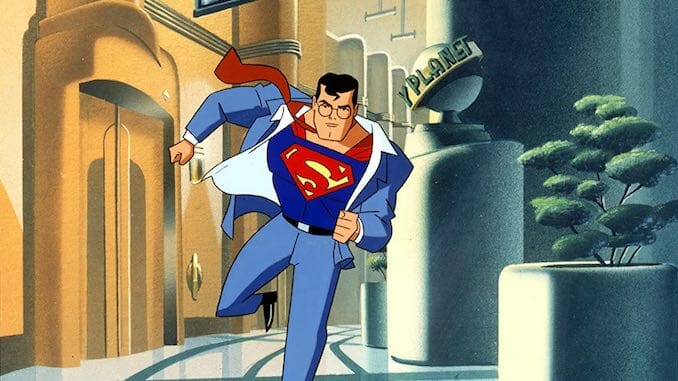What Superman: The Animated Series Has to Teach Us About Who Superman Is
Looking back at the newly restored ’90s cartoon, and how it compares to the DCEU
Photo Courtesy of Warner Bros.
You don’t really need to overthink Superman. He has complexities, but he’s not complicated. He charges headlong into conflict, but he’s not conflicted. He’s invincible, but he’s not invulnerable. And yet recent film adaptations of him, in particular, have insisted on bringing to bear the same tools and methods used to shape more modern heroes, in ways that are detrimental to the character. Simply put, Superman isn’t a Christ allegory. He isn’t Batman, or the Punisher. He isn’t angry, or violent, or aggrieved, or traumatized. His superpower isn’t that he has superpowers. It’s that he has superpowers and is still a good guy, because he was raised right.
DC and Warner Bros. actually had a great handle on this back in the ’90s, when the creators of the much-loved Batman: The Animated Series in turn created Superman: The Animated Series. As the entire show recently became available in crisp HD for the first time courtesy of HBO Max, it’s a great time to look back at why it really might be the best and most true-to-origin adaptation of Superman.
Lois: “I’ve lived in Metropolis most of my life and I can’t figure out how some yokel from Smallville is suddenly getting every hot story in town.”
Clark: “Well, Lois, the truth is I’m actually Superman in disguise, and I only pretend to be a journalist in order to hear about disasters as they happen and then squeeze you out of the byline.”
Lois: “You’re a sick man, Kent.”
You can tell an awful lot about a Superman adaptation by its Lois, and if we’re judging Superman: The Animated Series solely on Dana Delany’s hard-boiled metro reporter, there’s simply no contest. The series starts with an all-time great cast, centered on the trio of Tim Daly’s Clark Kent, Delany’s Lane, and a Lex Luthor portrayed by Clancy Brown, whose every line reading indicates he’s having the time of his life. Just as with its precursor, the show was ably guided by voice director Andrea Romano, whose efforts elevated cartoon shows for decades.
It’s all in service to stories that put new spins on classic Superman plot elements and characters. Superman: The Animated Series doesn’t assume its viewers haven’t ever seen a Superman story before, but it also understands that every adaptation needs to lay out the ground rules and do something new with them. The show’s first season is a master class in bringing everybody up to speed on the Man of Steel. The epic three-part pilot “The Last Son of Krypton,” sees the fall of Superman’s homeworld, the discovery of his powers and heritage as an awkward teen in Smallville, and his emergence as the hero of Metropolis and a nemesis of Lex Luthor. The show swiftly follows up with episodes that establish Kryptonite, the Fortress of Solitude, and big baddies like Brainiac.
The series’ latter seasons went bigger and more epic, introducing more classic villains and upping the stakes. The Kryptonian criminal Jax-Ur (Ron Perlman!) makes an appearance, and of course, the one and only Darkseid (Michael Ironside) is set up as Superman’s ultimate foe.
The latter’s portrayal, particularly, ranks among the most dramatic story arcs in any superhero show in recent memory. After an arrival that establishes him as a warmongering tyrant and killer, Darkseid makes another play at enslaving Earth by using brainwashing on Superman. It leads to a final conflict that sees the two dragging each other across the surface of Apokolips. It’s one of the best arcs in any DC comics-based show, period.
-

-

-

-

-

-

-

-

-

-

-

-

-

-

-

-

-

-

-

-

-

-

-

-

-

-

-

-

-

-

-

-

-

-

-

-

-

-

-

-








































